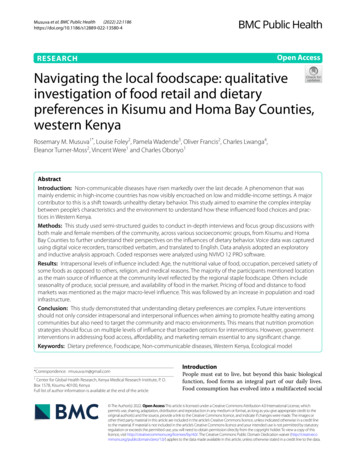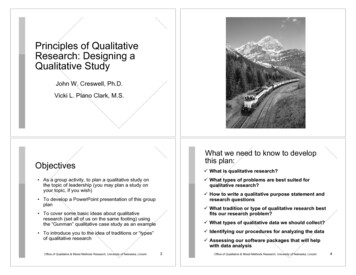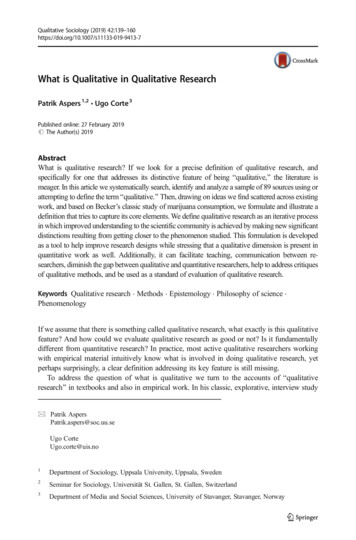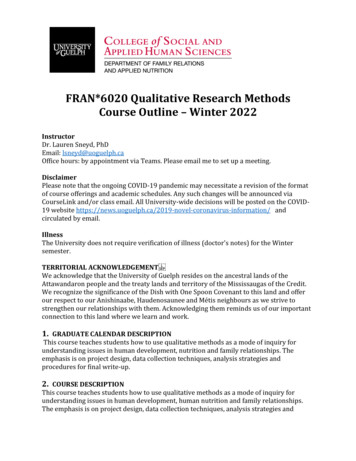
Transcription
(2022) 22:1186Musuva et al. BMC Public en AccessRESEARCHNavigating the local foodscape: qualitativeinvestigation of food retail and dietarypreferences in Kisumu and Homa Bay Counties,western KenyaRosemary M. Musuva1*, Louise Foley2, Pamela Wadende3, Oliver Francis2, Charles Lwanga4,Eleanor Turner‑Moss2, Vincent Were1 and Charles Obonyo1AbstractIntroduction: Non-communicable diseases have risen markedly over the last decade. A phenomenon that wasmainly endemic in high-income countries has now visibly encroached on low and middle-income settings. A majorcontributor to this is a shift towards unhealthy dietary behavior. This study aimed to examine the complex interplaybetween people’s characteristics and the environment to understand how these influenced food choices and prac‑tices in Western Kenya.Methods: This study used semi-structured guides to conduct in-depth interviews and focus group discussions withboth male and female members of the community, across various socioeconomic groups, from Kisumu and HomaBay Counties to further understand their perspectives on the influences of dietary behavior. Voice data was capturedusing digital voice recorders, transcribed verbatim, and translated to English. Data analysis adopted an exploratoryand inductive analysis approach. Coded responses were analyzed using NVIVO 12 PRO software.Results: Intrapersonal levels of influence included: Age, the nutritional value of food, occupation, perceived satiety ofsome foods as opposed to others, religion, and medical reasons. The majority of the participants mentioned locationas the main source of influence at the community level reflected by the regional staple foodscape. Others includeseasonality of produce, social pressure, and availability of food in the market. Pricing of food and distance to foodmarkets was mentioned as the major macro-level influence. This was followed by an increase in population and roadinfrastructure.Conclusion: This study demonstrated that understanding dietary preferences are complex. Future interventionsshould not only consider intrapersonal and interpersonal influences when aiming to promote healthy eating amongcommunities but also need to target the community and macro environments. This means that nutrition promotionstrategies should focus on multiple levels of influence that broaden options for interventions. However, governmentinterventions in addressing food access, affordability, and marketing remain essential to any significant change.Keywords: Dietary preference, Foodscape, Non-communicable diseases, Western Kenya, Ecological model*Correspondence: rmusuva.m@gmail.com1Center for Global Health Research, Kenya Medical Research Institute, P. O.Box 1578, Kisumu 40100, KenyaFull list of author information is available at the end of the articleIntroductionPeople must eat to live, but beyond this basic biologicalfunction, food forms an integral part of our daily lives.Food consumption has evolved into a multifaceted social The Author(s) 2022. Open Access This article is licensed under a Creative Commons Attribution 4.0 International License, whichpermits use, sharing, adaptation, distribution and reproduction in any medium or format, as long as you give appropriate credit to theoriginal author(s) and the source, provide a link to the Creative Commons licence, and indicate if changes were made. The images orother third party material in this article are included in the article’s Creative Commons licence, unless indicated otherwise in a credit lineto the material. If material is not included in the article’s Creative Commons licence and your intended use is not permitted by statutoryregulation or exceeds the permitted use, you will need to obtain permission directly from the copyright holder. To view a copy of thislicence, visit http:// creat iveco mmons. org/ licen ses/ by/4. 0/. The Creative Commons Public Domain Dedication waiver (http:// creat iveco mmons. org/ publi cdoma in/ zero/1. 0/) applies to the data made available in this article, unless otherwise stated in a credit line to the data.
Musuva et al. BMC Public Health(2022) 22:1186instrument. It is a principal social and cultural activity that people enjoy for aesthetic or communal reasonswhile connecting people across cultural boundaries [1].However, dietary behaviors have increasingly becomea cause for concern because of their associations withill health and mortality. Analysis of the Global Burdenof Disease Study 2010 [2] shows that dietary factors arethe most important factors that undermine health andwell-being. It is recognized that malnutrition, includingundernutrition, micronutrient deficiencies, overweight,and obesity, as well as non-communicable diseases(NCDs) resulting from unhealthy diets, have high socialand economic costs for individuals, and families, communities, and governments [3].Globally, non-communicable diseases (NCDs) are theleading cause of death. According to WHO estimates,these diseases contributed to 36 million deaths globally in2008, accounting for 63% of 57 million total deaths [4]. Itis also projected that NCDs will account for an increasingabsolute number and proportion of worldwide deaths,rising to about 70% of deaths in 2030 [4]. About 80% ofdeaths related to NCDs occur in low- and middle-incomecountries (LMICs) [5]. In many ways, this shift is a continuation of large-scale changes that have occurred overtime.Economic development in LMICs together with recenttechnological innovations and modern marketing techniques have modified dietary preferences. This has led tomajor changes in the composition of diet which contributes to the prevalence of NCDs [6]. Specifically, there hasbeen a shift towards high fat, refined carbohydrate, anda low-fiber diet. These dietary changes and the relatedincrease in diet-related diseases are intensified in Africaby the rapid increase in urbanization. [7]. As seen inother countries, the rise of fast-food restaurants and theinflux of sugar-sweetened beverages are at an all-timehigh [8]. This is further exacerbated by the transformation of the local food environment with supermarketsinfiltrating the inner city and even rural neighborhoods[9], potentially replacing traditional wet markets offeringfresh food and produce [10].This is particularly true in Kenya where the middleclass boom has resulted in a larger market for processedfoods from supermarkets and a decline in fresh foodsavailable in traditional markets. Supermarkets in urbanKenya have risen from a tiny niche a half-decade ago to afifth of food retail, spreading well beyond the richer consumers to derive more than a third of their sales and halfof their customers from low income and poor consumers. The United Nations Sustainable Development Goal(SDG) 2 seeks “to end hunger, achieve food and nutrition security, improve nutrition, and promote sustainable agriculture” [11]. Against this backdrop, “improvingPage 2 of 11knowledge and understanding about food environments– including the who, what, when, where, why, and howof food acquisition and consumption – will be key toaddressing malnutrition in all its forms” [12]. Food choiceis a complex phenomenon, affected by many interrelatedfactors described by various levels of influence. Thisstudy, therefore, sought to explore the influencers of dietary choices and preferences across three levels of influence -– interpersonal, community, and national/policyamong residents of Homa Bay and Kisumu Counties inWestern Kenya. This evidence is essential to support thedesigning of policies and interventions that appropriatelyleverage agricultural biodiversity, in concert with components of other food systems, to address the multiple burdens of malnutrition in LMICs.The analysis described here draws on baseline findingsfrom a larger ongoing mixed-method natural experimental study evaluating the impacts of a new hypermarket (supermarket combined with a department store)on dietary behavior and the local foodscape in WesternKenya [13]. The main aim of this analysis was to explorethe relationship between food retail and dietary behavioramong members of the community in Western Kenya.The study was conducted in two study sites: The intervention site (Kisumu, where the hypermarket is beingdeveloped) and a comparison site (Homa Bay, an equallycosmopolitan town but without a hypermarket).Materials and methodsConceptual frameworkThe ecological model was adopted in the formulation ofdata collection tools. This model recognizes the complex interplay that exists between an individual and thevarious levels of interaction with the environment [14].This was particularly appropriate in the study context ofa middle-income country facing rapid economic growthand a shift in culture alongside changing local foodscapes.The choice of food could be influenced at multiple levels. Individual characteristics such as level of education,knowledge or perception of healthy food, and personalpreferences could shape choices. Using the communityas the second level of interaction seeks to understand acommunity’s norms and culture and the role they playin the general health and wellbeing of its people. Examples can be drawn from taboo foods, communal sportingactivities, groups, or organizations in the community thatpromotes or hinder healthy dietary behavior. In addition,the enabling or limiting factors at the national level couldalso influence the local foodscape: for instance, the levelof tax on certain foods, levies on fast food restaurants,advertisements on highly processed foods, or policies onthe location of malls and wet markets.
Musuva et al. BMC Public Health(2022) 22:1186Study siteThe study was conducted in Kisumu and Homa Baycounties, in Western Kenya. These settings have a population of 1,155,574, and 1,131,950, respectively [15]. Twostudy areas were defined: the hypermarket interventionarea (Mamboleo, Kisumu) and a comparison area with nohypermarket (Sofia, Homa Bay). These areas were delineated using existing spatial census data, field visits, andlocal knowledge. A 2 km radial buffer was drawn aroundthe hypermarket and matched according to populationdensity with a 2 km radial buffer around Sofia as the landmark in the comparison area. Both sites display similarfood retail, socioeconomic (both lower and higher), andtopographical characteristics. Dominant socioeconomicactivities in both sites include fishing, small-scale farming, and the steady growth of both Counties leading to anincrease in consumers seeking convenient shopping avenues such as supermarkets and upscale grocery vendors.Study designThis was a cross-sectional qualitative study involvingmembers of households who participated in the initialquantitative household survey [16], purposively sampledfor follow on qualitative data collection.Selection of participantsWith the establishment of primary health care networks(PCNs) and subsequent implementation of the KenyaPrimary Health Care Strategic Framework 2019 – 2024[17], the study team worked closely with the departmentsof health in both Kisumu and Homa Bay Counties whichhave a functional community health unit [18]. Throughthis system, the community health volunteers (CHVs)who are at the first level of care and link households tohealth care facilities were recruited. Twenty communityhealth volunteers working within a 2 km radius of theLake Basin Mall and Sophia area assisted in generatinglists of 2000 households [13]. A stratified sampling technique (probability proportionate to size) was then usedto randomly sample by household SES (low, middle, andhigh – classification described in more detail below), distance (within 0.5 km, 1 km, and 2 km from the mall andSophia area) and quadrant (NE, NW, SE, and SW). Basedon these criteria, the final sample comprised 200 households estimated from the main protocol which assumeda 5% household food expenditure share, 80% power,95% confidence interval, and a 30% attrition rate [19].From these households, face-to-face questionnaires wereadministered. Finally, those who consented to participatefurther in the qualitative arm of the study after completing the questionnaires were then randomly selected fromthe various quadrants. Phone calls were later made toPage 3 of 11these individuals to confirm their availability and agreeon the time, date, and venue for the FGDs. For the indepth interviews, participants were purposefully selectedfrom a list of stakeholders previously engaged in thecommunity entry exercise of the study. IDIs took place inthe interviewee’s office or board rooms within the officebuildings.Qualitative inquiry methodsUsing the saturation model for qualitative data [20] ceasing additional data collection once which focuses onwhen the ability to obtain additional new informationhas been attained, four focus group discussions (FGD)each with a maximum of 12 participants were conducted in each county (for eight FGD total) stratified bygender, and social-economic status: i) Males from lowsocio-economic status households ii) Males from highsocio-economic status households iii) Females from lowsocio-economic status households iv) Females from highsocio-economic status households. The FGDs and indepth interviews (IDIs) were conducted in either Swahilior Dholuo after consensus from the participants.The focus group discussion guides (Additional file 1:Appendix 1) explored sources of food and reasons fortheir preference as well as household food staples andtheir reasons for this preference. 20 stakeholders wereidentified for the IDIs in Homabay County. The IDI discussion guide (Appendix 2) focused on similar themes tothe FGD guides. The IDIs conducted in Kisumu focusedon the upcoming hypermarket and the stakeholder’sinvolvement and were therefore excluded from thisanalysis.The study recruited experienced qualitative data collectors of bachelor’s degree level. Prior to the commencement of the study, a three-day training was conductedon understanding the study aims. A refresher trainingwas also offered on IDI and focus group discussion techniques and the discussion guides. After the training, thetools were piloted in both sites and necessary adjustments were made. Both the FGDs and IDIs were conducted by a moderator who was in charge of steering theconversation, and a notetaker who took notes verbatimand in addition captured the non-verbal cues during thediscussion. The interviews took an average of one and ahalf hours each for the FGDs and close to forty minutesfor the IDIs. They were conducted in either Swahili orDholuo. These discussions were held at local venues suchas classrooms, community, and church halls and offices.The discussions were recorded using an audio recorder.Data analysisThe thematic analysis used in this study was informed bythe blended approach to coding described by Graebner
Musuva et al. BMC Public Health(2022) 22:1186[21]. The audio recordings were transcribed verbatiminto Microsoft Word. The transcripts were then translated into English and back-translated to ensure nomeaning was lost. Transcripts were checked against thenote-takers details notes and audio recordings to ensurethey were a true reflection of the proceedings thereforenot warranting correction from the study participants.Three experts first read the transcripts iteratively to generate ideas through data immersion. Initial codes werethen systematically generated within and across the fulldataset. Themes were identified among the codes, andthese were discussed and modified until consensus wasreached. Saturation was reached before all the transcripts were analyzed because no new codes were identified when coding the last interview. The final themeswere checked against the coded extracts and the fulldataset. Once key themes had been identified, the finalstage included defining which data qualities each themecaptured, and a detailed analysis was written to describethe theme, including relevant sub-themes. Finally, theresearch team worked collaboratively to develop an intercoder agreement [22]. Discrepancies were resolved ona case-by-case basis until a full agreement was reached.The coding tree is provided as a supplemental file.ResultsSocio‑demographic characteristics of the studyparticipantsThe study recruited 33 and 38 participants in Kisumuand Homa Bay Counties respectively giving a total of 71respondents. This group constituted of males and femalesaged 20–69 years from different socio-economic groups.The majority of the participants constituted thosebetween ages 30–39, 31.6% in Homa Bay while in Kisumuthose between 40–49 formed the majority by 27.3%. Onboth sites, 50% of participants were married and hadattained at least primary school level education. A summary of the sociodemographic details of the focus groupdiscussion participants held with community members inKisumu and Homa Bay Counties is presented in Table 1.A summary of in-depth interview participants is provided in Table 2.Interpersonal influencesChoice of foodParticipants cited perceived satiety of some food types,age, occupation, taste, preference, and medical reasons assome of the influencing factors on what they would eat.The amount of money one has was mentioned by most ofthe participants.“People who engage in strenuous activities takeheavy foods, they like Githeri (a mix of maize andPage 4 of 11beans) sweet potatoes and all the rest You willmostly find that those who go for construction workwhen you go to the construction site you will findthat they do not eat light food.” ( Boda Boda rider,IDI Respondent, Homabay).“ It will depend on the pocket. You know here theprice of tilapia. So, you will have to buy omena (Silver Cyprinid) and feed your family. The money youhave is what will determine what you feed them”(Male FGD Respondent, Kisumu).“Age is a factor. For example, the elderly they cannot eat githeri some might not be able to chewmeat. So here you have to think carefully what cansuit them. But the youth are not limited to thesethings”. (Female FGD Respondent, Homabay).It was interesting to note that majority of the participants were of the opinion that the choice of food wasdependent on the person’s gender. The women were ofthe opinion that most men preferred traditional staplefood like cassava and ugali (maize meal) while the womensettled for what they considered to be lighter meals- riceand chips.“ you realize that there are those foods that ladieslike as opposed to men. Like sometimes I’ll get anopportunity to go to the hotel with even my femalecolleagues. While they would prefer even eatingfoods like maybe chips and sodas, most of us menwould prefer eating other foods like maybe “ugali” And I’ve realized that ladies, the majority of ladiesare the ones that like the snacks, those fast foods.That is my own opinion” (Agricultural Officer, IDIRespondent, Homabay).Household food staplesA majority of the participants especially in Kisumu mentioned local vegetables (e.g. sukumawiki). Other popularfood items included: Omena (Silver cyprinid) boiled maizeand beans, and ugali (maize meal) as staples in households. This monotony would be broken by beans, eggs,rice, or beef. The reasons mentioned by participants as towhy these particular foods were preferred include affordability, perceived nutritive value, religion, satiety, medicalreasons, and personal preferences. These responses werealso consistent with their responses about what people inthe community, in general, would normally eat.“ As for my family, we cannot take meat. We prefer the beans and the others. We attend the SDAchurch and are encouraged to eat that.” (Male FGDRespondent, Homabay).
Musuva et al. BMC Public Health(2022) 22:1186Page 5 of 11Table 1 Sociodemographic characteristics of FGD participants in Kisumu and Homa BayKisumu CountyDescriptionHoma Bay CountyFrequency(n 33)Percentage (%)Frequency (n 38)Percentage (%)GenderFemale1545.52155.3Male1854.51744.7Age al 23.7A-Level/college30.99615.8Didn’t disclose10.0300OccupationFormal ed oyed39.09615.8Didn’t disclose0012.6Marital 615.8Frequency of food purchaseTable 2 In-depth Interview I really like traditional vegetables because I get satisfied whenever I take them, there are some nutritional benefits that our bodies gain whenever wetake that food, that is why I like taking traditionalvegetables”. (Female FGD Respondent, Kisumu).Responses on the frequency of food purchases varied fromparticipant to participant. For some, a weekly budget for thedry goods (cereals, flour) and daily purchase of perishablegoods such as milk and vegetables was more feasible. Onlya few suggested that they purchase foodstuff once a month.The majority of participants however reported making thesepurchases daily. Reasons provided for the daily purchase offood included: the need to ensure the family eats fresh food,a daily wage that only allows one to spend what is earneddaily, and a lack of cold storage facilities (refrigerators).“Because I can’t say that I get money to buy the foodfor one week. At times I can get like one hundredshillings, I buy breakfast. Maybe I can buy sugar andmandazi(doughnut) for the children to eat. Lunchhour, I can get vegetables and maybe buy supper too.For me to get money to buy food for one month, ishard”. (Female FGD Respondent, Homa bay).
Musuva et al. BMC Public Health(2022) 22:1186Foods for special occasionsFor most families, special occasions include Christmas, when a child has done well in school when thefamily has guests or there is a family celebration.Meals provided on such special occasions include chapati (a round flat unleavened bread resembling naanusually made of whole wheat flour and cooked on agriddle pan) chicken, sweets, an assorted variety ofstore-bought baked goods, and food from the American fast food restaurant Kentucky Fried Chicken(KFC). The frequency of consumption of these foodsalso varied among participants with some quoting aweekly routine, others once every month, and othersonce or twice a year.“When the Lord bless me then I can cook chapattiwith chicken, and the children are always happybecause it is rare to get chicken in these areas.”(Female FGD Respondent, Kisumu)“That day I can bring them a cake, I go to the supermarket and buy cake, yogurt, milk, and such nicethings for them to be happy that day.” (FGD MaleRespondent, Homa bay)Change in foodscape over timeBoth FGD and IDI participants stated that the choice offood and even its source had changed over time. One ofthe common intrapersonal level influences mentionedwas convenience. Due to the nature of work, people areleft with little time to prepare food and opt for storebought options.“It has changed a lot, we have left the natural food,people have started preferring the readymade food because people have no time to try and settle in aplace and say I want to grow(plant crops and people don’t want even to go and do the sourcing for thatfood from where it is, people want to get ready mealsand that’s why they use hotels, they go to eatingplaces than preparing foods alone in their homes”(Partner coordinator, IDI Respondent, Homabay).Community influencesSources of foodLocation played a major role in the participant’sresponses as to where they got their food. A cleardichotomy was discernable regarding sources of foodbetween the two sites. In Homa Bay, a majority of theparticipants indicated they consumed food from theirfarms, including a variety of cereals, legumes, roottubers, vegetables, fruits, poultry, and dairy products.Page 6 of 11“Things like vegetable, pumpkin leaves we get fromthe farm even things like eggs, chicken we canget something small from the farms.” (Female FGDRespondent, Homa bay).This was in contrast to Kisumu where most participants reported that they get their food from anopen market, small local retail stores (kiosks), andsupermarkets.“It can happen that Kibuye (open market) is farand you are in a hurry. You go to Obunga to akiosk here instead of going to Kibuye, I take maybeat the kiosk some sugar. On the side of vegetables,I go to a stall, I take Sukuma (local green vegetable) or omena (small endemic fish) or tomatoes.”(Female FGD Respondent, Kisumu).Household food staplesOther community level influencers mentioned bythe participants include Available foods in the market, regional staple foods, seasonality of produce,convenience,“ . it comes a time when there are no Irish potatoes may be because the areas that plant it doesnot have it and the Omena also have a seasonfrom April to July, towards the end when the wateris very cold, and they are not available. You willfind that there are some species like Tilapia thatare not found or are very few, so you will find thatthere will be a change in the type of food dependingon the circumstance.” (Fisherman, IDI Respondent,Homa Bay).The existence of taboos about food was mentionedas a cultural/ community influence. There are someparts of the chicken that women were prohibitedfrom eating. In addition, mothers-in-law are not supposed to eat chicken in their son-in-law’s house as asign of respect.“. There are some foods that are taboos that areassociated with food. Like some people in the community, they may say women are not supposed toeat eggs and even to eat chicken so those are taboosbut they are not written” (Public Health Officer, IDIRespondent, Homabay).Some participants were of the opinion that food choiceis also influenced by individuals wanting to be associated with a particular social class and wanting to fit in,therefore choosing to eat foods considered ‘classy’ eventhough they sometimes struggle to afford them.
Musuva et al. BMC Public Health(2022) 22:1186Food purchasing and preparationGender roles in the community played a major role infood purchase and preparation. Although some participants on both sites mentioned that both the man andwoman participate in the purchase of food, the majorityagreed that the women were solely responsible. Theirreasons for this also varied.“ the man wouldn’t know the whole budget. He canbuy vegetables and fail to buy tomatoes. Again forme, on the same amount of money, I may notice thebaby may need fruits even if it is 5/- ( USD 0.05)and maybe he won’t be able to remember somethinglike that”. (Female FGD Respondent, Kisumu).“As for me, this issue why we like to give them (wives)is because of cooking, they are the ones who knowhow they schedule the menu, so you cannot forcethem to cook the food she did not want, because ifshe decides on her own, then she will cook it nicely we do not like buying She is the one who knows howto coordinate what food to be eaten in her house, youknow, that today I want to cook githeri ( a mix ofmaize and beans), tomorrow I want chapati, so sheis the one who knows how she runs the house, so youcannot just do things your way, so matter food, youleave to her”. (Male FGD Respondent, Kisumu).The majority of the participants were of the opinionthat it was the women who prepared meals in the home.Some of the reasons cited include the working hours ofthe man of the house and traditional expectations.“Most of us agree here it is the wife who cooks. Iknow how to cook, but it is just known she is theone who makes meals for us you also have toremember we are away from the home most of theday at work, so it is easier when she is the one preparing meals”. (Male FGD Respondent, Kisumu).Some participants also observed that both men andwomen were involved in the cooking while others citedolder children lending a hand in preparing meals.“In cooking, the children cook, I also cook and my wifealso cooks. Because there are children who have grownup and have learned the art of cooking, and perhapswe may go on a journey like a funeral at my in-laws,will the children sleep hungry? I have taught them howto cook.” (Male FGD Respondent, Homa bay).Change in foodscape over timeParticipants mentioned the change in the physical environment as a major source of concern. Climate changehas affected the seasons making it difficult for farmersPage 7 of 11to plan planting seasons. This has also affected the production of fish in the lake.“. It has already changed and will continue tochange. Right now, the rains have become unreliable for a while The harvests have not been goodfor a while. Even the fishermen say there is less fishin the lake these days, that’s why you hear of fishcages these days we are also going for food whichis already canned in the markets, in the supermarkets so our sources of food will definitely change we’llgo for industrial, industrially manufactured foodinstead of farm-produced food so it will change.”( Officer in the Ministry of Water, IDI Respondent,Homabay).National/ macro‑level influencesChoice of food and food staplesThe majority of the participants from both IDIs andFGDs mentioned distance to food markets as a majordeterminant of what people ate in households. This especially stood out from participants from Homa Bay.“ Yes, there are a number of people who travel toget food because most towns are not food sufficient,if they have cereals, they don’t have the greens ifthey have the greens they don’t have the cereals sothey are forced to travel to get what they don’t have families along the lake will have fish but theywill not have the cereals and the ones in the upperregions will have cereals but will not have the fishso they are forced to travel to sell or travel to obtainfood which they do not have.” (NEMA officer, Homabay).Other factors mentioned as influencing the choiceof food at the macro level include Food prices, politicalinsta
food retail, socioeconomic (both lower and higher), and topographical characteristics. Dominant socioeconomic activities in both sites include shing, small-scale farm-ing, and the steady growth of both Counties leading to an increase in consumers seeking convenient shopping ave-nues such as supermarkets and upscale grocery vendors. Study design










